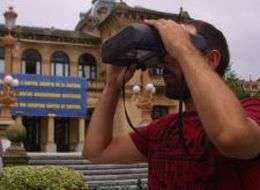Augmented reality brings movie magic to city visits

(PhysOrg.com) -- From the Italy of Visconti to the Spain of Almodovar, many people's first encounter with a foreign country is in the cinema. Imagine if images from the silver screen could be conjured up anew when they do visit, for real?
Using a combination of personalised location-based services and augmented reality, in which multimedia content is superimposed and merged with real-time images, a team of European researchers and city authorities has created a device to bring a little movie magic to city visits by tourists, cinema lovers, inquisitive local residents and film professionals.
The device, which resembles a pair of binoculars with an integrated camera and LCD screen, was tested in San Sebastián, Spain, and Venice, Italy, and is continuing to be developed with a view to creating a commercial product. It uses a hybrid tracking system to provide location-based information, and cities’ wireless communications networks to download and share multimedia content.
“European cities have a wealth of audiovisual content, from historical images and documentary footage to film scenes and photographs, which they can use to enhance the experiences of visitors, local residents or even film professionals,” explains María Teresa Linaza, a researcher at the Vicomtech research centre in San Sebastián and technical coordinator of the EU-funded CINeSPACE project. “Until now, there have been few ways to share this.”
More immersive experience than smart phones
Though smart phones incorporating features such as location-awareness and augmented reality (AR) applications have come onto the market in the three years since the CINeSPACE project began, Linaza notes that none offer the same immersive experience provided by a dedicated platform and device.
Unlike staring at the small screen of a smart phone, the CINeSPACE device is held up to the eye like a pair of binoculars, allowing users to see multimedia content superimposed on a city scene, be it a popular shopping street or an historical square.
Users are guided around a city by an intelligent sensor-fusion system incorporating GPS, WLAN tags, inertia cubes and marker-less optical tracking. Personalised location-aware services tell them where to go and where to stand for the best AR experience. And maps and other multimedia content are provided via a 4.5-inch LCD touch panel on the binocular device, with user preferences taken into account when selecting points of interest and content. The project partners say the device could be rented out by local tourism offices.
“In St. Marks Square in Venice, for example, users could position themselves where Audrey Hepburn stood and view the basilica... Or they can watch historic footage of how the square used to look,” Linaza says.
Content may consist of video, photos or audio recordings, stored on a central server of the municipality and downloaded as required, and can come from a variety of sources, including the users themselves.
Sharing user-generated content
“Besides film footage and images taken from city archives, we also wanted to give users the ability to generate and share their own content. Users could, for example, take photos and video with the built-in camera and leave virtual notes at different locations which could then be picked up and viewed by other users over the Wi-Fi network,” the project technical coordinator explains. “A group of friends could also use the communications network to stay in touch as they explore the city.”
The CINeSPACE system was tested in San Sebastián and Venice last summer, with trial users rating highly the overall concept of the system and the quality of the AR content. Further work, aimed at addressing user feedback regarding the device and interface, has since led to a third prototype being developed by German micro-electro-optical device manufacturer and project partner Trivisio, which is planning to commercialise it.
“For tourists and local citizens, AR and location-aware systems such as this offer a new way of discovering a city or even rediscovering their own city,” notes Gorka Diez, coordinator of the EU-funded CINeSPACE project and a project manager at Fomento de San Sebastián, a municipal company involved in the economic and technological development of the city.
“In the trials in San Sebastián we also used it to help film professionals scout for film locations, and to show local citizens more about their own city. The reaction of many was: ‘Wow, I didn’t know that film was shot here!' Or 'I didn’t know this area used to look like that!’.”
With AR and location-based systems such as that developed by CINeSPACE likely to gain in popularity in the future, many more people can expect to experience such eye-opening surprises and learn more about the cities where they live and the places they visit.
More information: CINeSPACE project - www.cinespace.eu/
Provided by ICT Results

















